Does the Lydian Dominant Scale seem somewhat cryptic to you?
If you’re a guitarist looking to put some more spice into your solos: look no further…
In today’s post, we’re going to:
- Discuss the Lydian Dominant scale with its various names and applications;
- Take a look at how to lay out the Lydian Dominant Scale on the guitar fretboard, and
- The best ways to practice and master it for improvisation.
Bonus PDF Download: Get access to a print friendly pdf version of the exercises in this article as well as a backing track to use for your practice session.
By the end of this post, you’ll have a clear path for using the Lydian Dominant scale on guitar for your solos.
Along the way, we’ll answer your theory questions, give you a bit of a historical context, and the essential tips on how best to apply this cool scale to your soloing.
Let’s dive in!
Video Sections:
00:00 Introduction
01:20 What is the Lydian Dominant Scale?
01:50 When To play Lydian Dominant For Soloing
02:12 Lydian Dominant Scale Method 1: Relationship To The Lydian Mode
03:16 Lydian Dominant Scale Method 2: Mode Of The Melodic Minor Scale
04:06 Lydian Dominant Scale Method 3: ‘Chord/Scale’ Method
04:33 Lydian Dominant, ‘Acoustic Scale’ and the Overtone Series
05:10 Examples of Lydian Dominant Songs
06:06 Lydian Dominant Guitar Scale Approach #1: Single String Method
07:52 Lydian Dominant Guitar Scale Approach #2: Box Position Method
09:04 Lydian Dominant Guitar Scale Approach #3: Diagonal Method
11:11 Wrap Up & Next Steps
What is The Lydian Dominant Scale?
To construct the Lydian Dominant Scale from a given root note we can follow the following formula (let’s use C as the root for this example):
| C Lydian Dominant: | C | D | E | F# | G | A | Bb |
| Formula: | 1 | 2 (or 9) | 3 | #4 (or #11) | 5 | 6 (or 13) | b7 |
| Interval Spacing:(T = Tone, S = Semitone) | T | T | T | S | T | S | T |
Here’s what the scale looks like in notation:
C Lydian Dominant Scale Notes:

When To Play Lydian Dominant:
Lydian Dominant is an excellent scale choice to use over most dominant chords, especially dominant chords with a #11 or b5 in the chord name, such as D7#11 (which is the same way of saying D7b5).
Now let’s discuss 3 ways of understanding this scale:
Lydian Dominant Scale Method 1: Relationship To The Lydian Mode
Something I need to answer first and foremost:
Why is it called Lydian Dominant?
Notice how the name may remind you of another scale – the Lydian mode.
In fact:
Both the Lydian and Lydian Dominant scales are nearly identical – sharing the characteristic sharpened 4th degree:
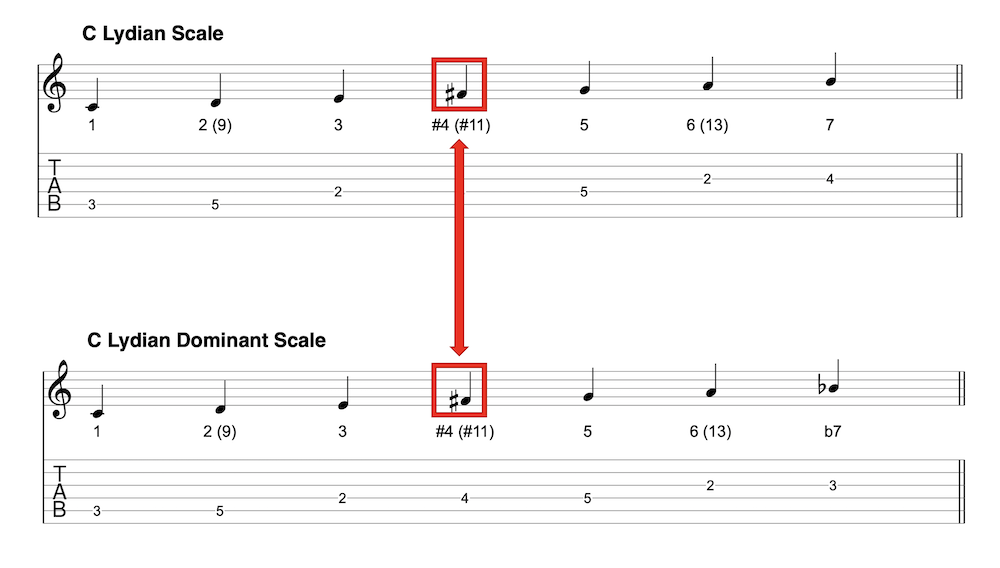
Our friend Lydian Dominant shares six out of seven notes with the Lydian Mode – all except the b7 at the end.
That b7 note explains the word ‘Dominant’ in the name.
Why?
The b7 note is the characteristic interval of dominant chords:
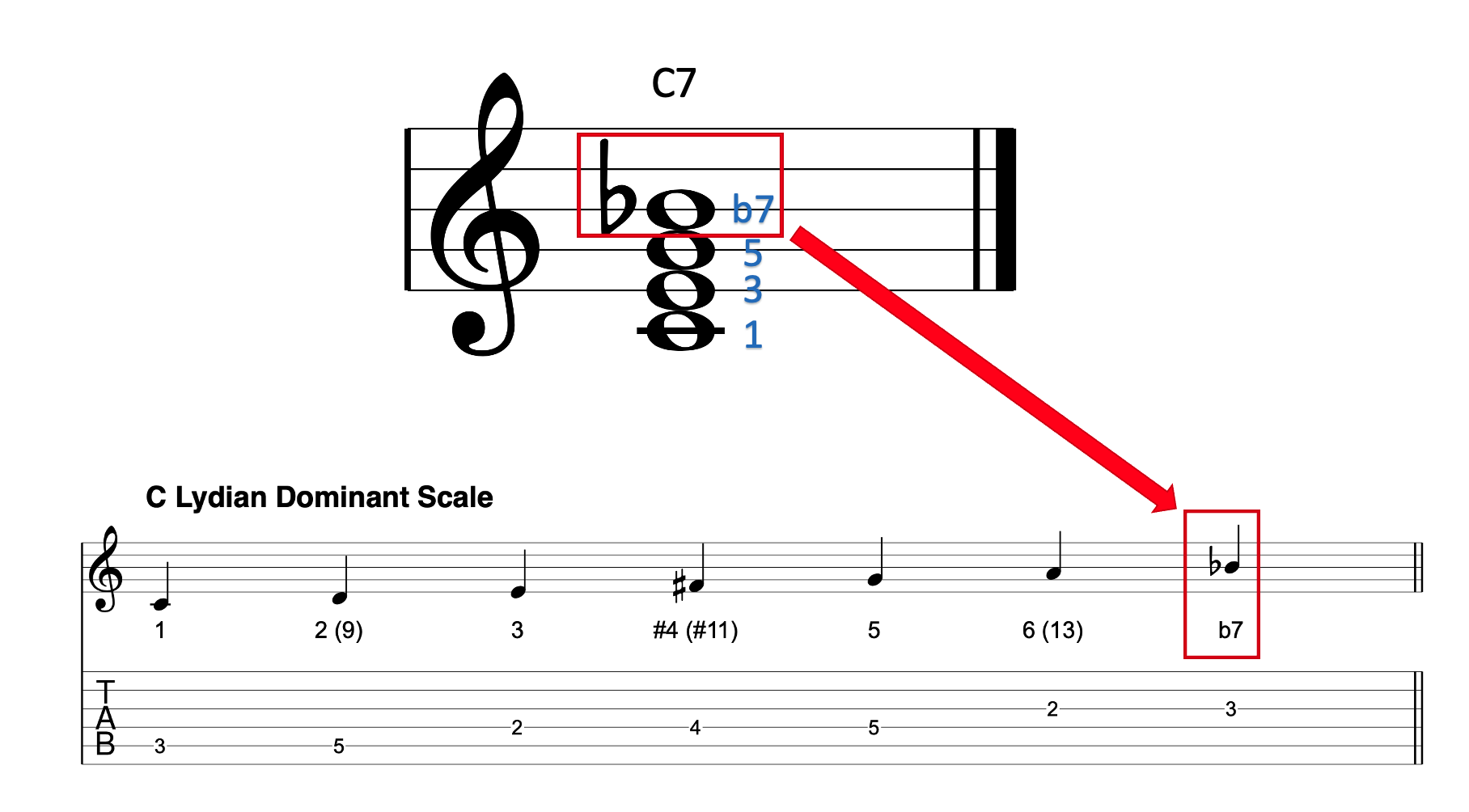
For this reason, this scale is sometimes referred to as a ‘Lydian b7 scale’.
In summary:
A good way to think of this scale is:
Take the Lydian mode, and lower the 7th one semitone (i.e. one fret).
I like this method as it’s easy to understand.
BUT for the sake of completion, let’s cover some other interesting ways to understand this scale below…
Lydian Dominant Scale Method 2: Mode Of The Melodic Minor Scale
Another useful way of looking at the Lydian Dominant Scale is as the 4th mode of the Melodic Minor Scale.
Confused? Let me explain.
Let’s take A melodic minor as an example:

Now play the same notes but start on D (i.e. the 4th degree) instead of A:
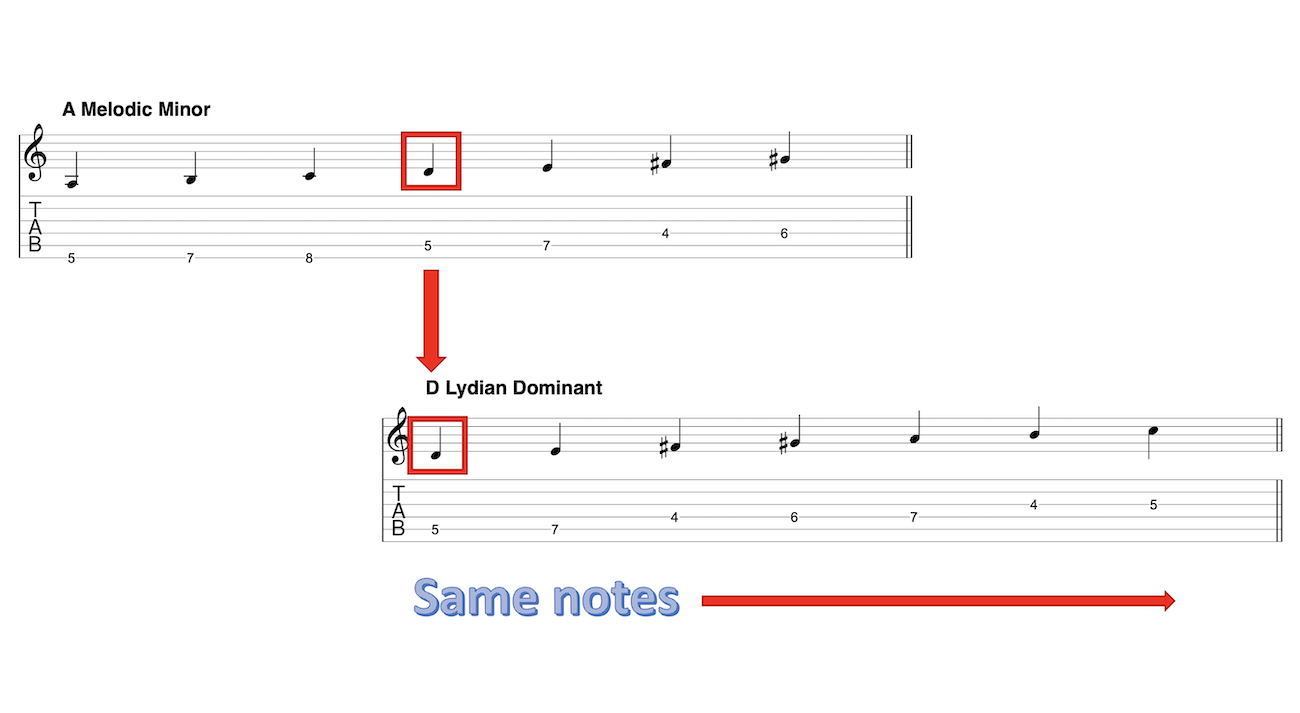
Voilà – you now have a Lydian Dominant Scale!
This is good news if you’ve already mastered the melodic minor scale itself.
An example:
Let’s say the band is playing a funky vamp on a D7 chord:
Simply play an A melodic minor scale over the D7 vamp – although you’re thinking A melodic minor, it will result in a Lydian Dominant sound over that chord.
Cool, huh?
Give it a try over the Youtube backing track above.
(Bonus tip: Try starting A melodic minor on the G# (the 7th degree) and you’ll get an Altered Scale, the 7th mode of melodic minor – but that’s a story for another day.)
Lydian Dominant Scale Method 3: ‘Chord/Scale’ Method
Understanding a scale in terms of how it relates to a chord is very useful as a jazz improviser.
The reason?
If you understand a scale as a set of chord tones, you can clearly see how each note in the scale relates to the chord you are soloing on.
Most chords are built by stacking thirds.
Let’s examine a D13#11 chord in this way, which is a D7#11 with a 13 added. We can build this chord by starting with the D root, then stacking 3rds on top:

Collapse these chord tones into a single octave, and here we are with our scale of the day – the Lydian Dominant Scale:

This is where those numbers 9, #11, and 13 came from in our Lydian Dominant scale formula – they relate to their position in the vertical structure of the chord rather than their horizontal position in the scale.
This is the essence of the chord scale theory: chords and scales are the same things, just one is vertical and the other horizontal.
Lydian Dominant, ‘Acoustic Scale’ and the Overtone Series
Interesting fact:
The Lydian Dominant scale has a direct relationship to the overtone series – the naturally occurring resonance in nature when a fundamental tone is sounded:

If you approximate the harmonic series to the nearest semitone, overtones 8 through 14 precisely spell out Lydian Dominant, hence the terms ‘Acoustic Scale’ or ‘Overtone Scale’ that are sometimes used to describe this scale:

It’s intriguing to think that every note you hear has Lydian Dominant hidden mysteriously within those vibrations…
Examples of Lydian Dominant Songs:
Mostly everyone on the planet would be intimately familiar with the sound of Lydian Dominant in its pure form.
Why?
It’s the main scale used in the iconic theme music by one of the most favorite TV shows of all time:
Have a go at playing The Simpsons on your guitar – a fun Lydian dominant scale melody to get used to the sound in a variety of keys.
Jazz Tunes That Use The Lydian Dominant Scale
An appearance of a dominant 7#11 chord is a clear invitation for jazz improvisers to look at using Lydian Dominant.
One of the most famous jazz examples that features a dominant 7#11 sound is none other than Duke Ellington’s Take the A Train:
(You’ll often see the chord notated in jazz charts as D7b5, but it’s just another label for the same chord, D7#11.)
In addition to the D7#11 chord used, the melody also gives us a clue with that Lydian raised 4th in the 3rd bar:
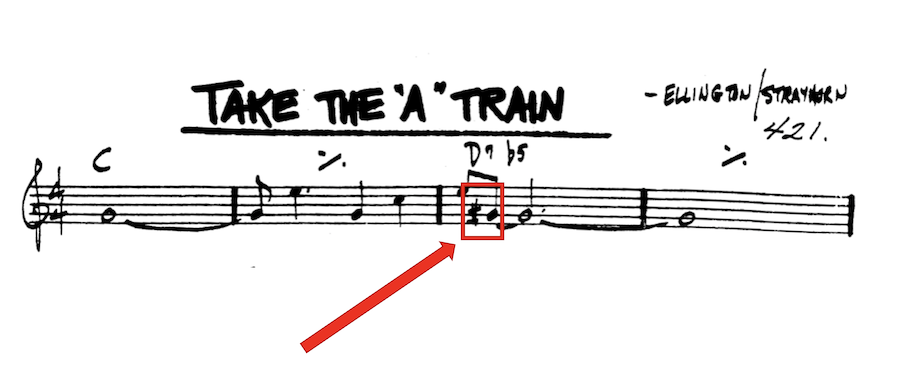
Now there’s a perfect place to flex our Lydian Dominant muscle on.
Here’s another – Blue 7 by Sonny Rollins, who uses the Lydian Dominant scale in the head of this song:
Not a well-known tune, but a fine example of a melody written using Lydian Dominant. Like other Blues heads, the melody transposes to the subdominant in bars 5-6 and then returns.
Where Do I Start With The Lydian Dominant Scale On The Guitar?
Being able to quickly see the pattern on your fretboard is the goal of all scale practice.
Let’s sketch out several strategies for mastering the Lydian Dominant mode (i.e. the Lydian b7 scale) on guitar.
Lydian Dominant Guitar Scale Approach #1: Single String Method
A good place to start is to be able to play the Lydian Dominant guitar scale on a single string.
The reason:
Playing a scale on a single string like this gives you a feel for the distance between each note, i.e. whether the notes are a whole step or half step apart.
Step 1:
To get started, play this scale starting from an open D on the 4th string then play the scale only on that string:
D Lydian Dominant On 4th String

Exercise: Run the scale up and down a string and then just improvise little melodies by ear; this should help you connect what you see with what you hear and bypass excessive thinking. Try it out over this D7 drone:
Notice how every note in this scale sounds good – there are no notes to ‘avoid’ which makes it very easy to apply over dominant chords.
Step 2:
The next step is to locate the D root on another string (say, the G-string) and apply the scale formula to that string instead:
D Lydian Dominant on 3rd String

Note: the diagram only goes up to the 12th fret, but see if you can figure out how to continue to play the scale beyond that.)
Step 3:
Rinse and repeat for the remaining strings. After we’re done with all that we end up with a full fretboard map of the scale:

Lydian Dominant Guitar Scale Approach #2: Box Position Method
The next stage of Lydian Dominant scale guitar proficiency is position playing.
A position is all the notes you can play without shifting your whole hand up or down the neck; typically spanning 4 frets plus one on each side if you stretch/pivot.
Important note:
It’s overkill, in the beginning, to try to memorize every different box position pattern of the Lydian Dominant scale.
For now, stick to these positions with the root on the low A and E strings, as they are generally the easiest positions to relate to common bar chord shapes:
A String Root (Diagram starts on 4th fret)
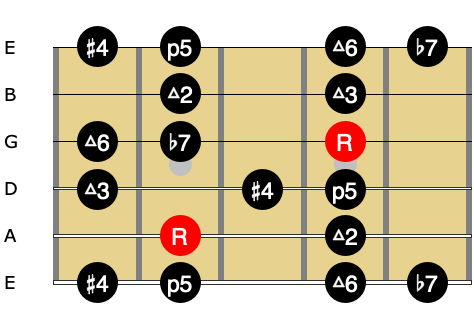
E String Root (Diagram starts on 9th fret)
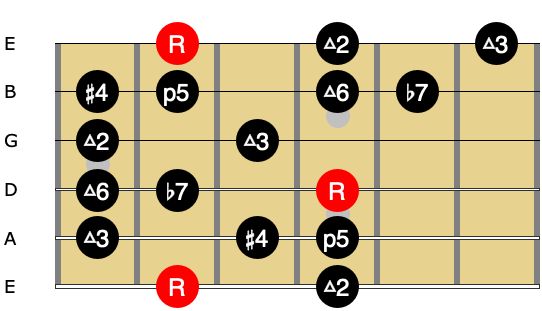
Once you’re familiar with these 2 shapes, you think of them as two ‘islands’, which you can then travel between via the single string approach we covered earlier in this lesson:

Lydian Dominant Guitar Scale Approach #3: Diagonal Method
This is where you can visualize the fretboard in one-octave scale patterns linked diagonally across the fretboard.
Have a go at the following pattern (note that suggested fingering is on the diagram this time instead of intervals):
D Lydian Dominant – Diagonal Scale:

You can also do a very similar pattern starting with your root note on the 6th string. Let’s try this with a G root note instead:
G Lydian Dominant – Diagonal Scale:

This approach is the best of both worlds: a combination of the ‘horizontal’ single string approach and the ‘vertical’ box positions – carving out a ‘diagonal’ approach that covers the whole range of the instrument.
Also:
Most of the one-octave patterns are very similar, which helps for easy memorization of the scale. (For more on this kind of scale approach, check out my detailed post on the Tree jazz guitar scale system here.
Keep in mind:
Everyone learns differently, so you might favor one approach over the other for laying out this scale on the fretboard.
Experiment with each approach and see what makes the most sense.
Lydian Dominant Guitar Scale Approach #4: Letting go – A Taste Of Freedom

The last and the most desired level of scale proficiency is as close to total freedom on the fretboard as you can get.
It’s when you have the whole fretboard map visualized and burned in your muscle memory from using one or a combination of the above approaches.
Here’s what to do (try looking at the fretboard map above if you don’t have it completely visualized yet):
- Start at the lowest note in your register and work your way up somehow through the scale to the highest note; then go back.
- Pay attention to how you change the positions and keep the fingering comfortable; otherwise, avoid following a strict ‘approach’ or rules.
- Take as much time as you need with each note.
This final approach will help you intuitively find the notes of the scale and will develop your ear training. It is the most powerful and flexible of all the approaches we’ve covered.
Level Up With These Fun Lydian Dominant Scale Guitar Exercises
Here are some practice ideas to give you some possibilities of how you could improvise with this scale:
Lydian Dominant Scale Guitar Exercise #1: Groups Of Three and Four
Have a go at these simple sequences of groups of three:
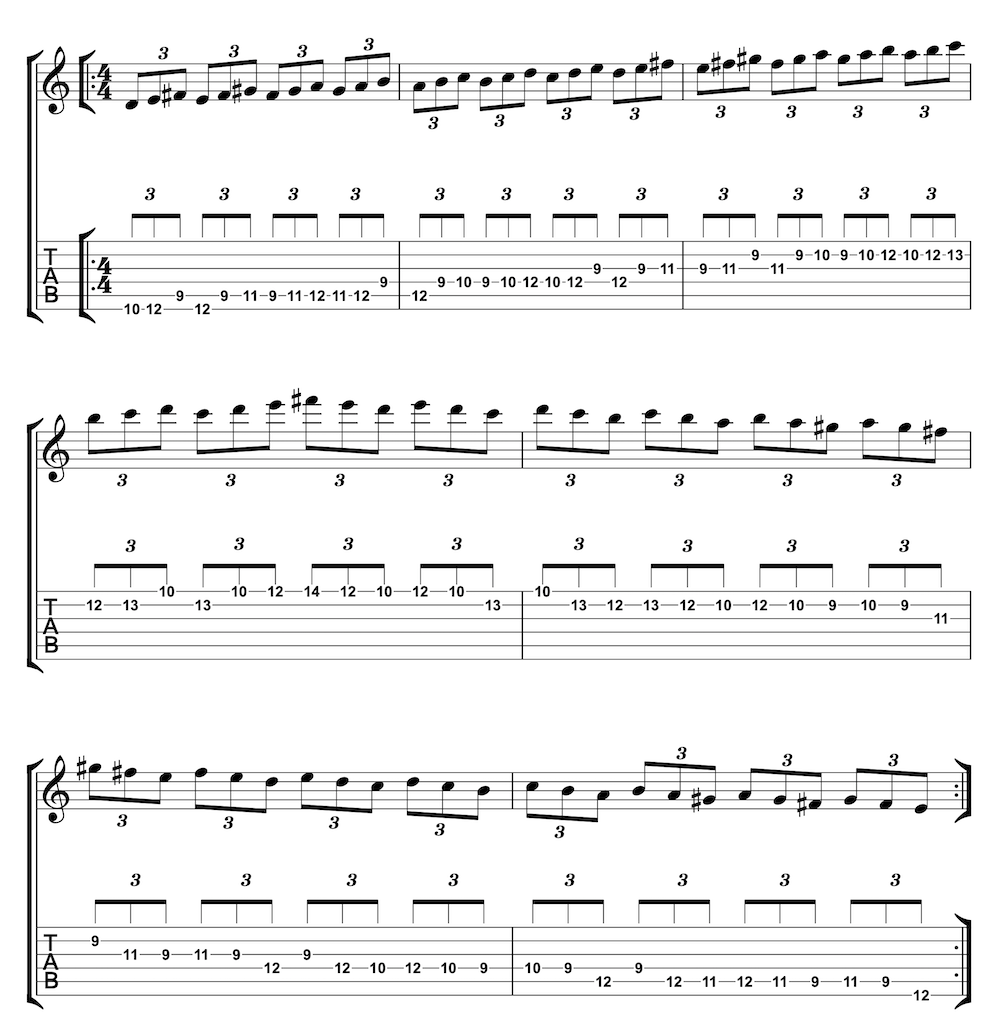
And now this example, where this time the pattern is arranged in groups of four:
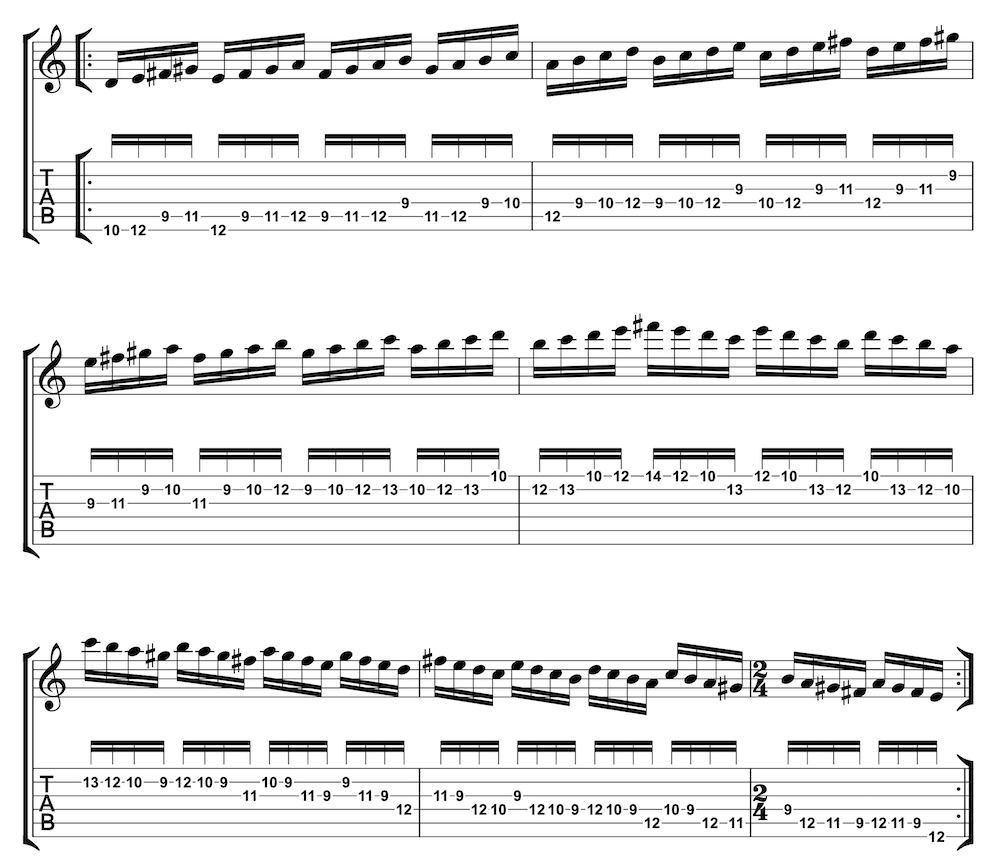
Lydian Dominant Scale Guitar Exercise #2: Skips Not Steps
Just playing the scale by its steps can get pretty stale.
Any scale you work on should also be played with skips. Here’s an example of Lydian Dominant with skips of thirds:
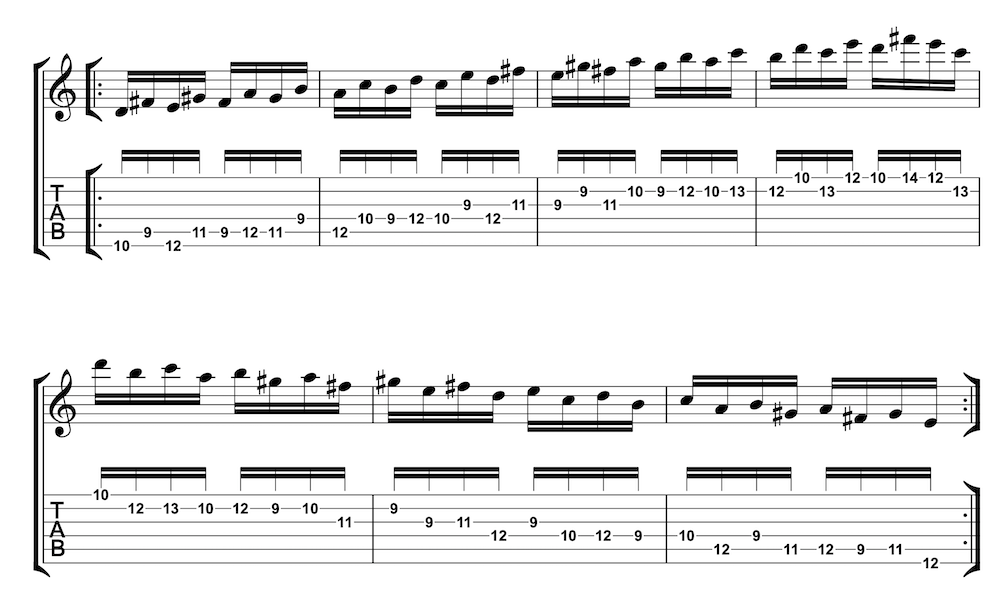
I encourage you to work out the same approach with other intervals, but nailing the 3rds is more than a good start.
Lydian Dominant Scale Guitar Exercise #3: Trippy Triads
Another fun and useful thing to practice is sequences of triads based on the notes in the Lydian Dominant scale (hint: this should be easier if you’ve worked on the 3rds above).
These Lydian Dominant arpeggio patterns can create a hip contour to your lines when soloing:
The examples above are written with a box position approach in mind, but you can just as well apply the sequence ideas to single strings (horizontal) and the range-based approach (diagonal).
Try coming up with your own patterns or Lydian dominant licks based on the exercises above.
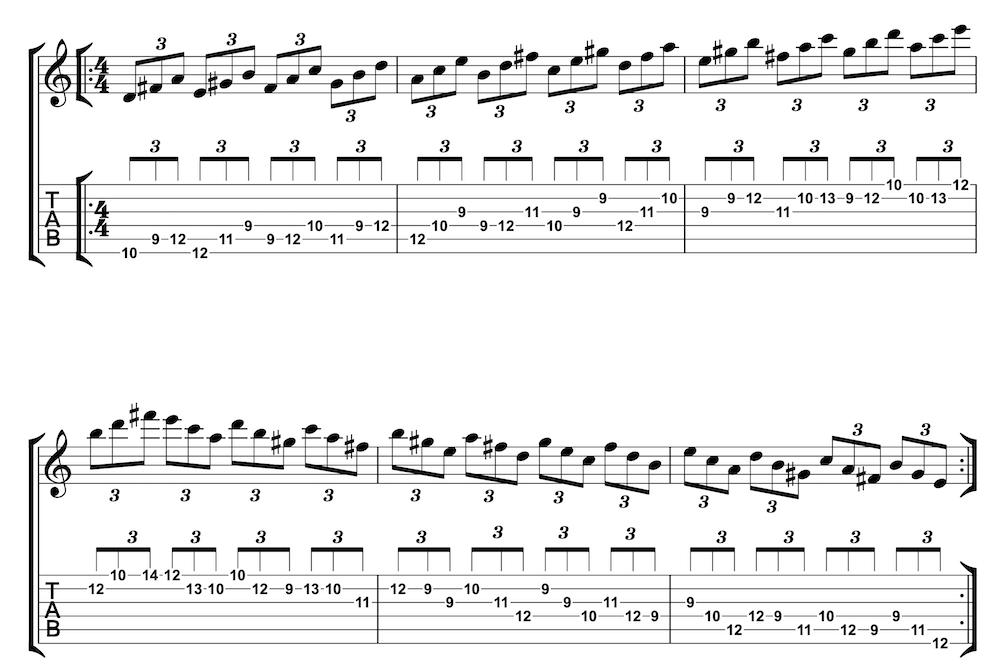
Summary:
The Lydian Dominant Scale could be considered the complete Dominant 7 sound, which, unlike other scale choices, feels very stable and resolved.
Insights and Tips:
- Other names for this scale are Lydian b7, acoustic scale, or the overtone scale.
- No note of this scale clashes with a straight dominant seventh chord sounding underneath.
- When to use Lydian dominant: The #11 is the characteristic note which, when appearing in a melody over a dominant chord, invites the use of the scale.
- Whenever there is a section of a form that has a prolonged dominant pedal or vamp, the Lydian Dominant Scale would be one of the main candidates for the job.
- Particularly useful in Blues tunes, where you would choose to play the dominant 7th chords for the I and IV degrees – that’s where you can show off all the sequences and licks you’ve come up with while working on the above-mentioned exercises.
- Another good place could be the bridge of a Rhythm Changes tune – plenty of opportunities over all those dominant 7th chords!
Bonus PDF Download: Get access to a print friendly pdf version of the exercises in this article as well as a backing track to use for your practice session.
Further Resources:
- Excellent lydian dominant scale video by Fretjam, covering more of the theory and how to use the scale for improvisation. There is also a handy post to go with that video as well.
- Speaking of videos, here’s another very useful deep dive on the Lydian Dominant Scale theory & application by Tony Winston.
- Nice concise post from Ari’s Bass Blog on using Lydian Dominant to solo over dominant chords and more helpful info.
- One more video, this time by QJam – packed full of helpful info and good example of using the scale in the context of styles other than jazz.
Conclusion:
Practicing the Lydian Dominant Scale on guitar thoroughly will be a great asset for your fretboard knowledge and muscle memory.
While it is not the only way to think about dominant chords, it’s definitely a fruitful one – a sound that lets you spread your wings over a Dominant 7 vamp, or shred hip Alan Holdsworth or John Coltrane-like runs.
Hit us up in the comment section with your thoughts or questions that are left unanswered – let’s get the discussion started…
About The Authors:

Greg O’Rourke, BMus (Hons), ANU – Founder of FretDojo.com
Greg O’Rourke is the FretDojo Academy’s main instructor and the founder of FretDojo.com – one of the most popular jazz guitar websites online today. Greg’s mission is to empower guitarists worldwide with the tools to make great music by providing high quality step-by-step courses and materials.
Greg has many thousands of subscribers to his website and Youtube channel from all across the world, and is also an established author, with his book on jazz chord melody, The Easy Guide To Chord Melody Guitar becoming an international bestseller.
Greg’s website has helped thousands of people improve their jazz guitar playing, and he’s been featured on several high profile jazz guitar websites including Jazz Guitar Online, Fundamental Changes, and Takelessons.

Danil Zverkhanovsky, (BA), Jazz Guitar
Danil Zverkhanovsky is a Ukrainian musician and producer based in Berlin and Kyiv. He has released his solo debut album In Pieces Suite in 2017, has released music as a co-leader of the band Bird Dreams and worked on various projects by other artists as a guitarist as well as a producer/mixer.
Danil was born in Kyiv in 1994 and has studied music with emphasis on guitar in the Glier College of Music in Kyiv, University of Arts Graz and Jazz Institute Berlin. Among his most notable teachers were Volodymyr Shabaltas and Kurt Rosenwinkel.
He is currently working on multiple projects including solo albums, new music for Bird Dreams as well as single releases in diverse genres.
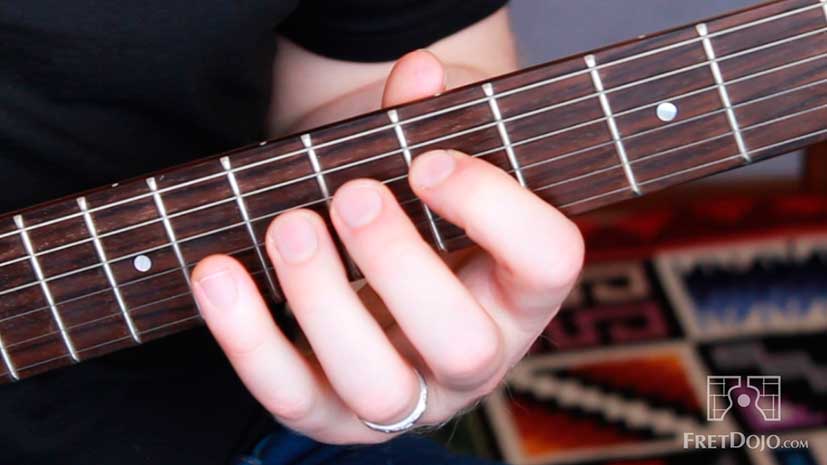

Wow, Greg. You are a phenomenal teacher; and provided a very comprehensive lesson and resources. Loved it! Thanks!